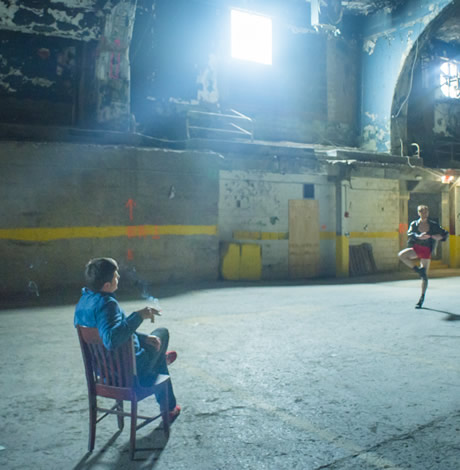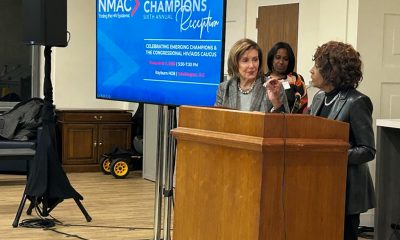Arts & Entertainment
Remembering a queer visionary
New force/collision work celebrates iconic late filmmaker


A scene from ‘Jarman.’ (Photo by Benjamin Carver)
‘Jarman (all this maddening beauty)’
Through April 27
Atlas Performing Arts Center
1333 H Street N.E.
$10-20
202-399-7993
Iconoclastic ‘80s filmmaker Derek Jarman was a standout among his peers. Gay and fearless, Jarman eschewed traditional movie making methods for more experimental, semi-narrative forms. His films like “Sebastiane” and the “Caravaggio” are deeply personal, wildly inventive and strongly homoerotic. He’s best remembered as one of the founding fathers of new queer cinema.
This year marks the 20th anniversary of Jarman’s death from AIDS complications. In commemoration there are myriad salutes and retrospectives, mostly in London. Washington-based theater company force/collision is celebrating the artist with its latest offering “Jarman (all this maddening beauty).”
Acted and staged by the company’s founding director John Moletress and written by Obie Award-winning playwright Caridad Svich with filmed footage by talented local filmmaker Ben Carver, “Jarman” combines theater and film to create a glorious mishmash of sound, images and live performance.
“In making the project,” says Moletress who identifies as queer, “We sought inspiration from Jarman’s work. We weren’t attempting to recreate or make a comment. We approached it from a contemporary point of view keeping in mind how we’re making art today. You’ll see images of the left’s then-nemesis Margaret Thatcher, but you’ll also see images of Putin as well.”
At 80 minutes, “Jarman” is a solo show staged on a spare set, reminiscent of the filmmaker’s bare-bones studio. Moletress plays both the title character and a young artist from today. And while he’s the only actor onstage, 50 other actors contribute performances through voiceover and film projection.
“Jarman’s work is beautiful and rageful,” Moletress says. “As a filmmaker, he cared about community, queer identity and ensemble work. So does force/collision. Company members are involved in all facets of the production, but our intent has always been to tour ‘Jarman’ (it’s slated to play in England in the fall) and from a financial perspective it’s more feasible with a cast of one.”
The show’s footage was shot by Carver on locations throughout D.C., including the Arboretum and the shuttered, historic Washington Coliseum (located near Union Station) where the company staged a decadent end-of-the-world party.
“It was sort of an apoplectic tea dance,” Moletress says. “We had fog machines, a DJ, cheap Champagne and lots of actors drawn from D.C.’s mainly underground performance art scene. Ben (Carver) was instrumental in accessing unique locations and some interesting and well-built actors.”
In keeping with Jarman’s aesthetic, the production is homoerotic and there’s nudity.
“I’m naked onstage — that’s something I haven’t done since I was a twink. But I’m not nervous. I’m more concerned about dressing as Margaret Thatcher and dancing around violently with a butcher knife while giving the audience lap dances … and remembering my lines.”
As a 16-year-old video store clerk, Moletress, 35, saw his first Jarman film “Aria” (’87) featuring the filmmaker’s career-long muse Tilda Swinton. He was smitten. Moletress became further intrigued as an undergrad at Muhlenberg College in Pennsylvania when one of his English classes screened Jarman’s “Tempest” (’79).
Then last year, while doing “Gun Control Action Theatre” with playwright Caridad Svich, the pair agreed to collaborative on a project involving Jarman. “It was then that I really began watching all of his films and reading everything I could find about him. In my research, I learned that Jarman was a charming and determined man. Still, the deeper I delved, there was always more to know about him.”
Jarman arrived at filmmaking via art school. His early works include the sexy “Sebastiane” (‘76), about the martyred gay saint, and “Jubilee” (’78) featuring punk star Adam Ant. His best known film is “Caravaggio” (’86), in which the filmmaker celebrates the painter’s obsession with his thuggish studio model.
After being diagnosed with HIV while filming “The Last of England” (’86), Jarman continued to work, staging the Pet Shop Boys’ 1989 tour and making more films, working with big names like Judi Dench and Laurence Olivier. He spoke publicly about his illness and became increasingly active in the gay rights movement. Jarman died in London in 1994 at 52.
Moletress counts Jarman as a deserving member of the gay Pantheon: “There’s no shame in his work. Jarman didn’t pander. He made what he wanted to make. If it offended some people, he didn’t give a shit. Jarman never said no to his sexuality or to what he wanted to see on film.”
Bars & Parties
Mixtape Sapphics hosts holiday party on Dec. 13
‘Sugar & Spice’ night planned for Saturday

Mixtape Sapphics will host “Sapphic Sugar & Spice: A Naughty-Nice Mixtape Holiday Party” on Saturday, Dec. 13 at 4 p.m. at Amsterdam Lounge.
This is a festive, grown holiday party for queer women and sapphics 35 and older at Revolt’s Christmas pop-up. There will be music, joy, and an optional White Elephant.
This is Mixtape Sapphics’ first-ever holiday party — a cozy, flirty, intentionally grounded night created just for queer women and sapphics 35+ who want real connection, festive joy, and a warm place to land at the end of the year.
Tickets start at $13.26 and can be purchased on Eventbrite.

Friday, December 12
“Center Aging Friday Tea Time” will be at 12 p.m. in person at the DC Center for the LGBT Community’s new location at 1827 Wiltberger St., N.W. To RSVP, visit the DC Center’s website or email [email protected].
Go Gay DC will host “LGBTQ+ Community Happy Hour” at 7 p.m. at Freddie’s Beach Bar and Restaurant. This event is ideal for making new friends, professional networking, idea-sharing, and community building. This event is free and more details are available on Eventbrite.
Women in Their Twenties and Thirties will be at 8 p.m. on Zoom. This is a social discussion group for queer women in the Washington, D.C. area. For more details, go to Facebook.
Saturday, December 13
Go Gay DC will host “LGBTQ+ Community Brunch” at 12 p.m. at Freddie’s Beach Bar & Restaurant. This fun weekly event brings the DMV area LGBTQ+ community, including allies, together for delicious food and conversation. Attendance is free and more details are available on Eventbrite.
The DC Center for the LGBT Community will host “Sunday Supper on Saturday” at 2 p.m. D.C.’s queer community will gather for good food, laughter, and community. For more information, email [email protected].
Sunday, December 14
SADBrunch will host “HokiSlay Drag Brunch” at 12 p.m. at Throw Social. This festive affair brings fierce performances, over-the-top holiday looks, and more sparkle than a tinsel explosion. Expect powerhouse lip-syncs, laughter, and cheer hotter than your spiked cocoa. Cake Pop will host the event. Tickets cost $28.52 and are available on Eventbrite.
Monday, December 15
“Center Aging: Monday Coffee Klatch” will be at 10 a.m. on Zoom. This is a social hour for older LGBTQ+ adults. Guests are encouraged to bring a beverage of choice. For more information, contact Adam ([email protected]).
Genderqueer DC will be at 7 p.m. on Zoom. This is a support group for people who identify outside of the gender binary, whether you’re bigender, agender, genderfluid, or just know that you’re not 100% cis. For more details, visit genderqueerdc.org or Facebook.
Tuesday, December 16
Center Bi+ Roundtable will be at 7 p.m. on Zoom. This is an opportunity for people to gather and discuss issues related to bisexuality or as Bi individuals in a private setting. Visit Facebook or Meetup for more information.
The DC Center for the LGBT Community will host “Self-Defense Class with Avi Rome” at 12:30 p.m. Rome is a proud member of the LGBTQ community and a full-time martial arts instructor with 25 years of teaching experience. He holds a Fifth Degree Black Belt in Jhoon Rhee Tae Kwon Do and is the director of the studio’s Adaptive Tae Kwon Do program for students with special needs. He has also run numerous self-defense workshops for various groups and situations. For more details, visit the center’s website.
Wednesday, December 17
Job Club will be at 6 p.m. on Zoom upon request. This is a weekly job support program to help job entrants and seekers, including the long-term unemployed, improve self-confidence, motivation, resilience and productivity for effective job searches and networking — allowing participants to move away from being merely “applicants” toward being “candidates.” For more information, email [email protected] or visit thedccenter.org/careers.
Asexual and Aromantic Group will be at 7 p.m. on Zoom. This is a space where people who are questioning this aspect of their identity or those who identify as asexual and/or aromantic can come together, share stories and experiences, and discuss various topics. For more details, email [email protected].
Thursday, December 18
The DC Center’s Fresh Produce Program will be held all day at the DC Center for the LGBT Community. People will be informed on Wednesday at 5 p.m. if they are picked to receive a produce box. No proof of residency or income is required. For more information, email [email protected] or call 202-682-2245.
Virtual Yoga Class will be at 7 p.m. on Zoom. This free weekly class is a combination of yoga, breath work and meditation that allows LGBTQ+ community members to continue their healing journey with somatic and mindfulness practices. For more details, visit the DC Center’s website.
Egypt
Iran, Egypt object to playing in Seattle World Cup ‘Pride Match’
Game to take place on June 26

Iran and Egypt have objected to playing in a “Pride Match” that will take place in Seattle during the 2026 World Cup.
The Egyptian Football Association on Tuesday said it told FIFA Secretary General Mattias Grafström in a letter that “it categorically rejects holding any activities related to supporting (homosexuality) during the match between the Egyptian national team and Iran, scheduled to be held in Seattle, USA, on June 26, 2026, in the third round of the group stage of the 2026 World Cup.” Football Federation Islamic Republic of Iran President Mehdi Taj told ISNA, a semi-official Iranian news agency that both his country and Egypt “protested this issue.”
The 2026 World Cup will take place in the U.S., Canada, and Mexico. The draw took place at the Kennedy Center on Dec. 5.
Iran is among the handful of countries in which consensual same-sex sexual relations remain punishable by death.
The State Department’s 2023 human rights report notes that while Egyptian law “did not explicitly criminalize consensual same-sex sexual activity, authorities regularly arrested and prosecuted LGBTQI+ persons on charges including ‘debauchery,’ prostitution, and ‘violating family values.’” Egyptian authorities “also reportedly prosecuted LGBTQI+ individuals for ‘misuse of social media.’”
“This resulted in de facto criminalization of same-sex conduct and identity,” notes the report.
The 2024 human rights report the State Department released earlier this year did not include LGBTQ-specific references.
Soccer has ‘unique power to unite people across borders, cultures, and beliefs’
The June 26 match between Iran and Egypt coincides with Seattle Pride. The Washington Post reported the Seattle FIFA World Cup 2026 Local Organizing Committee decided to hold the “Pride Match” before last week’s draw.
“As the Local Organizing Committee, SeattleFWC26’s role is to prepare our city to host the matches and manage the city experience outside of Seattle Stadium,” said SeattleFWC26 Vice President of Communications Hana Tadesse in a statement the committee sent to the Washington Blade on Wednesday. “SeattleFWC26 is moving forward as planned with our community programming outside the stadium during Pride weekend and throughout the tournament, partnering with LGBTQ+ leaders, artists, and business owners to elevate existing Pride celebrations across Washington.”
“Football has a unique power to unite people across borders, cultures, and beliefs,” added Tadeese. “The Pacific Northwest is home to one of the nation’s largest Iranian-American communities, a thriving Egyptian diaspora, and rich communities representing all nations we’re hosting in Seattle. We’re committed to ensuring all residents and visitors experience the warmth, respect, and dignity that defines our region.”
The 2034 World Cup will take place in Saudi Arabia.
Consensual same-sex sexual relations remain punishable by death in the country. The 2022 World Cup took place in neighboring Qatar, despite concerns over the country’s anti-LGBTQ rights record.
-

 Congress1 day ago
Congress1 day agoEXCLUSIVE: George Santos speaks out on prison, Trump pardon, and more
-

 Health4 days ago
Health4 days agoThe harsh truth about HIV phobia in gay dating
-

 Arts & Entertainment5 days ago
Arts & Entertainment5 days agoCynthia Erivo, Eva Victor, and ‘Blue Moon’ bring queer representation to Golden Globe film nominations
-

 Spain3 days ago
Spain3 days agoVictory Institute honors transgender Spanish senator in D.C.



















